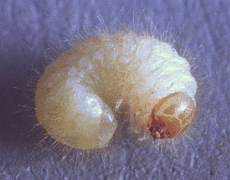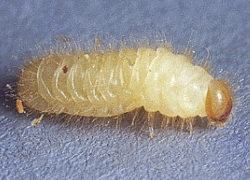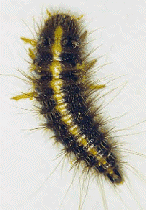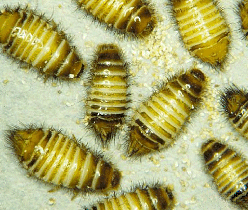INSECT FILES
Site Guide
Site Search
Home Page
Career Page
Insect Files
Shortcut to the main groups of insects and other arthropods...
Bug Rhymes & Poems
Links
Shop
Payments (credit/debit card)
|
Domestic Beetles |
Class: Insecta
Order: Coleoptera |
Look here for domestic beetles infesting stored food or attacking
fabrics and similar materials inside houses and other buildings . . . . . . |
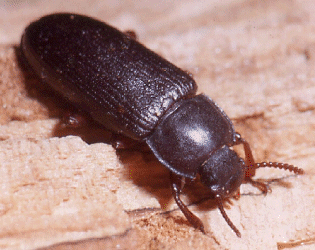
Mealworm Beetle, Tenebrio molitor
(actual size 12-18 mm long) |
Several beetles are common pest of stored food products and often
occur in houses, bakeries, grain stores and warehouses - anywhere that food is stored,
especially dried food stuffs such as grain, cereals, flour, nuts, etc. It is always
advisable to keep such foods in well sealed plastic or glass containers - this not
only keeps vagrant beetles out, but also prevents the spread of insects which might be
introduced accidentally (often as eggs and/or larvae) with newly purchased goods.
Some of the stored food pests, and a variety of other beetles that
frequently invade human habitations, can also damage clothing, carpets and other
household furnishings, attacking almost anything made from natural fabrics and furs.
Most of these beetles will not attack man-made fibres (nylon, polyester, acrylic, etc.),
so that clothing and furnishings made from these materials are relatively safe from
beetle-damage. |
|
Browse through the following descriptions and illustrations of the
more common domestic beetles - it may help you recognise these household pests. Most
species are cosmopolitan, having been spread worldwide through commercial trading.
|
Rice Weevil - Sitophilus (= Calandra)
oryzae (Family Curculionidae)
Typical weevil with a relatively long snout or rostrum projecting forward from the
front of the head and with distinctly elbowed antennae. Brown to almost black in
colour, usually with two paler marks on each wing-case (body 2-3 mm long). Found in
granaries, bakeries and other food stores where it will attack all kinds grain and
cereal products (maize, rye, wheat, millet, etc.) as well as rice.
[PICTURE IN THE BEETLE GALLERY]
<<< TOP |

Rice Weevil
|
Grain or Granary Weevil - Sitophilus granarius
(Family Curculionidae)
Very similar to the previous species, but without pale marks on the wing-cases (body
2-3 mm long). Likewise, it will attack most kinds of stored grain products.
[PICTURE IN THE BEETLE GALLERY]
<<< TOP |
Grain Weevil
|
Drug-store Beetle - Stegobium (= Sitodrepa)
paniceum (Family Anobiidae)
Also known as the Bread or Biscuit Beetle. Dark reddish-brown with obvious longitudinal
striae (impressed lines) on the wing-cases. Body 2-4 mm long, and covered with fine hairs.
Mainly found in bread and other products made with flour, but will also infest a wide
variety of other plant and animal products, including spices and drugs. The larvae are
small white grubs, up to 5 mm long (see below).
[PICTURE IN THE BEETLE GALLERY]
<<< TOP |

Drug-store Beetle
|
Cigarette or Tobacco Beetle - Lasioderma serricorne
(Family Anobiidae)
Small, rather short-bodied beetles, red or pale reddish-brown in colour and covered with
very fine hairs. Wing-cases more or less smooth, lacking obvious striae, and antennae
distinctly serrate (body 2-3 mm long). These beetles can bend their head a long way under
the thorax and curl themselves into a ball. Found in many plant and animal products, but
seems to have a special fondness for tobacco. Generally confined to warm buildings. The
larvae are small white grubs, up to 4 mm long (see below).
[PICTURE IN THE BEETLE GALLERY]
<<< TOP |

Cigarette Beetle
|
Grain Beetles - Oryzaephilus and Cryptolestes
(= Laemophloeus) species (Family Cucujidae)
Small, flat, reddish-brown beetles (body 2-4 mm long), similar in general appearance to
the Flour Beetles described and illustrated below. The two most important pest species are
the Saw-toothed Grain Beetle (Oryzaephilus surinamensis) and the Flat Grain Beetle
(Cryptolestes pusillus). They infest stored grain and other dry food products. The
Saw-toothed Grain Beetle is sometimes found outdoors living under tree bark and in fungi.
It gets its common name from the toothed edges of the thorax, a feature present in many
members of the family but particularly well developed in this species.
[PICTURE IN THE BEETLE GALLERY]
<<< TOP |
Saw-toothed Grain Beetle
|
Flour Beetles - Tribolium, Latheticus
and Palorus (= Caenocorse) species (Family Tenebrionidae)
Several species of reddish-brown beetles, all very similar in general appearance to the
Tribolium sp. illustrated opposite (body 2-4 mm long). All are fairly common pests
found in stored grain, flour, bran and other cereal products.
[PICTURE IN THE BEETLE GALLERY]
<<< TOP |

Flour Beetle (Tribolium)
|
Broad-horned Flour Beetle - Gnathocerus cornutus
(Family Tenebrionidae)
Reddish-brown, with a distinctive large tooth on each mandible (jaw), which gives the beetle
a 'horned' appearance (body 3-5 mm long). Like the previous flour beetles, it occurs in stored
cereals and cereal products. Also found outdoors living under the bark of old deciduous trees,
particularly that of elms.
<<< TOP |

Broad-horned Flour Beetle
|
Waste Grain Beetle - Alphitophagus bifasciatus
(= A. quadripustulatus) (Family Tenebrionidae)
Reddish or black with reddish-yellow and black markings on the wing-cases (body 2-3 mm long).
Can be found in a wide variety of stored food products, but mainly lives in old or damp flour,
mouldy grain and chaff. Also found outside in old, rotting deciduous trees and under mouldy,
decaying vegetation. In some regions it is quite common in stables and cow-sheds.
<<< TOP |

Waste Grain Beetle
|
Lesser Mealworm Beetles - Alphitobius species
(Family Tenebrionidae)
Entirely black or nearly so, with reddish legs and antennae (body 5-6 mm long). Found in
stored flour, bran and other cereal products. Generally seems to prefer old food stuffs
that are mouldy or otherwise damaged.
<<< TOP |

Lesser Mealworm Beetle
|
Mealworm Beetles - Tenebrio species
(Family Tenebrionidae)
The adult beetle is shown at the top of this page. Entirely black
or brownish-black (body 12-18 mm long). A common pest in stored flour, bran and other
cereal products. Sometimes found outdoors in the nests of birds and in old, hollow trees.
Single individuals found in the house are likely to have flown in through an open window
or door, since in the evenings they are attracted by lights. If present in numbers,
however, their breeding place is probably in the house and should be traced. The larvae,
commonly known as 'mealworms' (see below), are easy to rear, and
they are bred commercially in the pet trade as food for various small animals.
[PICTURE IN THE BEETLE GALLERY]
<<< TOP |

Mealworm Beetle
|
Cellar or Churchyard Beetles - Blaps species
(Family Tenebrionidae)
These large beetles are entirely dull black in colour, with a distinctive tail-like
extention of the wing-cases (body 20-30 mm long). They live in dark places in and
around houses and other buildings, typically in kitchens, cellars, sheds, stables and
barns, but may also occur in roof spaces where birds have been nesting. The beetles
feed on any spilled or waste animal and vegetable matter, including badly stored grain,
bran and other cereal products. When disturbed, these beetles have the interesting
habit of adopting a sort of 'headstand', by extending the hind-legs and pushing
against the ground, so tilting the whole body with tail-end upwards. If the disturbance
continues, they can squirt a smelly, yellowish-brown fluid from the raised tip of
the abdomen, sometimes to a distance of several centimeters. This fluid contains
quinones, which are powerful skin irritants and provide the beetles with an effective
defence mechanism to repel would-be predators.
[PICTURE IN THE BEETLE GALLERY]
<<< TOP |
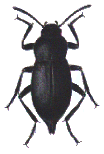
Cellar Beetle
|
Khapra Beetle - Trogoderma granarium
(Family Dermestidae)
Yellowish-brown, head and thorax usually darker than the wing-cases (body 2-3 mm long).
Only found in very warm buildings, mainly associated with stored grain and cereal
products. A common pest in the malting silos of breweries.
<<< TOP |

Khapra Beetle
|
Larder or Bacon Beetle - Dermestes lardarius
(Family Dermestidae)
Black, with a broad, wavy, yellowish-white or greyish band across the wing-cases broken
by several black marks. Body 7-10 mm long, and covered with fine hairs. Will attack various
products of animal origin in homes and warehouses, including bacon and other fatty meats.
Sometimes found in the nests of birds and rodents, as well as on dry animal hides, carcasses
and other animal matter. Old birds' nests in the roof spaces and eaves of buildings can be a
source of infestation and should be removed. When the larvae (see below)
are ready to pupate, they often chew pupation-holes in wood, cork, paper, textiles, mortar and
even soft metals, especially lead, and may cause considerable damage to these materials.
[PICTURE IN THE BEETLE GALLERY]
<<< TOP |

Larder Beetle
|
Hide or Leather Beetles - Dermestes peruvianus, D. haemorrhoidalis
& D. maculatus (= D. vulpinus) (Family Dermestidae)
The three similar dermestid beetles, commonly called hide or leather beetles, resemble the previous species
but lack the distinctive greyish band - instead,the whole body is covered with pale golden-yellow
or greyish hairs (body 6-10 mm long). Generally more common and widespread than the Larder Beetle,
but otherwise have similar habits.
<<< TOP |
Hide Beetle
|
Fur Beetle - Attagenus pellio
(Family Dermestidae)
Blackish-brown with two white spots on its back. Body 4-6 mm long, and covered with fine
hairs. The larval stages can do severe damage to skins, furs, carpets, old blankets and
the like. Also found in corn mills and grain stores.
[PICTURE IN THE BEETLE GALLERY]
<<< TOP |

Fur Beetle
|
Carpet Beetles - Anthrenus species
(Family Dermestidae)
Several very similar species, more or less round in shape and covered with patches and stripes
of whitish-yellow scales. These scales sometimes get rubbed off and the beetles appear dull
black in colour (body 2-4 mm long). When disturbed these beetles pull their legs close beneath
the body and remain motionless. Will attack furs, carpets and all kinds of woollen textiles.
The commonest pest species in Britain is the Varied Carpet Beetle (Anthrenus verbasci),
well known as a domestic pest, particularly in southern England. The adults are frequently
found outdoors on flowers, feeding on pollen and nectar. Another species, the Museum Beetle
(Anthrenus museorum), is sometimes a pest in museums where it can be very destructive
to animal and insect collections. The larvae of Carpet Beetles and other dermestids are covered
with long hairs and are commonly known as 'woolly-bears' (see below).
[PICTURE IN THE BEETLE GALLERY]
<<< TOP |

Carpet Beetle
|
Spider Beetles - Gibbium, Niptus and
Ptinus species (Family Ptinidae)
Brown or brownish-black, with relatively long legs and antennae. Body 2-5mm long, and usually
covered with fine hairs. Found in homes and warehouses, often in large numbers. Feed and develop
mainly on starchy materials such as grain and flour, but may attack all kinds of substances of
both plant and animal origin. The larvae, like those of some dermestid beetles, often chew
pupation-holes in wood and textiles and, likewise, may cause extensive damage to these materials.
Some species of Ptinus can survive outdoors, living in the nests of birds and in old
hollow trees.
[PICTURE IN THE BEETLE GALLERY] |
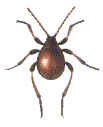
Gibbium psylloides |
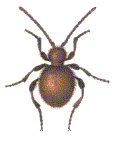
Niptus hololeucus |

Ptinus fur (male) |

Ptinus fur (female) |
|
<<< TOP |
Plaster Beetles - Cryptophagus and Latridius
species (Families Cryptophagidae and Lathridiidae)
Very small black or brown beetles (about 2 mm long), which frequently appear in newly-built
and reconditioned houses. Several kinds may be found and often occur together. They feed on
moulds and mildews and can only survive in damp conditions. The beetles may sometimes infest
food stuffs, fabrics, carpets, etc., that have become mouldy. The conditions found in new
and refurbished buildings suit them, since moulds may develop on recently plastered walls
and ceilings before drying-out has been completed. Generally, the beetles soon disappear
once everything has dried. Obviously, this can be hastened by keeping newly plastered and
decorated rooms warm and well aired. |

Cryptophagus |

Latridius (= Lathridius) |
|
<<< TOP |
Control of Domestic Beetles
Beetles attacking carpets and fabrics.
Control measures for household infestations of domestic beetles that attack carpets,
furs and other household fabrics (e.g., Carpet Beetles, Fur Beetles, Leather Beetles, etc.)
are the same as those described for Clothes Moths.
Beetles attacking grain, flour and other stored food.
Control measures for household infestations of domestic beetles that attack
dried food products (e.g., Grain Beetles, Flour Beetles, Mealworm Beetles, etc.) are the same
as those described for Meal & Flour Moths.
Plaster Beetles.
These beetles are harmless, but to avoid annoyance every effort should be made to trace and
rectify the source of dampness which attracts the beetles and allows them survive. Keeping
rooms warm and well aired to remove any trace of mustiness is especially important. Spot
treatments with a standard household insecticide for crawling insects can be used as a
temporary control measure to reduce any immediate nuisance caused by the beetles, but take
care to follow all the instructions on the product packaging and never use insecticides where
food is stored, prepared or eaten, or where people (especially children) and pet animals are
likely to come into contact with the chemical deposit.
REMEMBER TO USE INSECTICIDES SAFELY AND FOLLOW ALL THE INSTRUCTIONS ON THE PRODUCT LABEL |
|
MORE ON BEETLES
Order Coleoptera
<<< HERE >>> |
|
|
<<< TOP |
(use the back button on your web browser to return to the previous page) |
TOP >>> |
|


